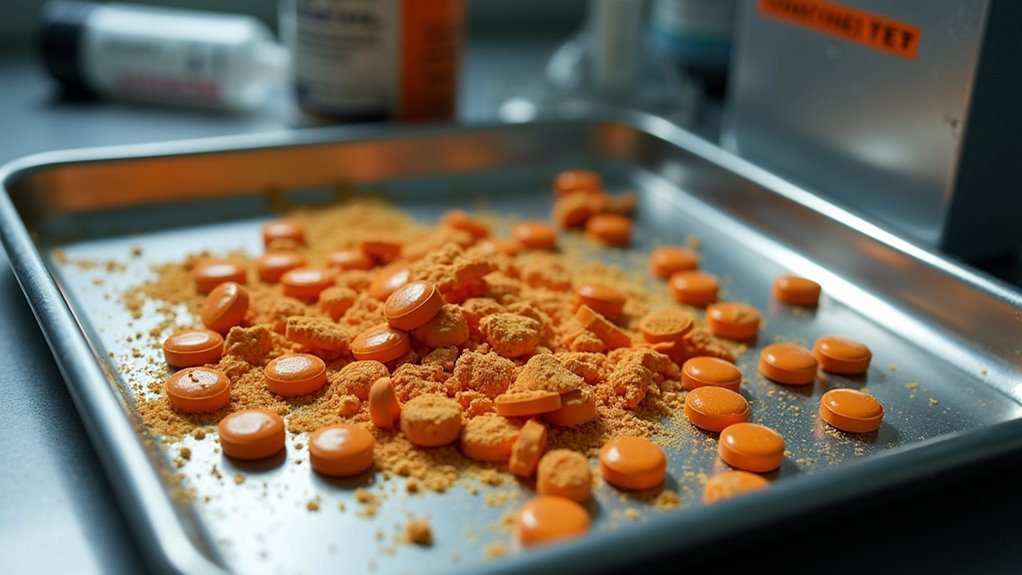Suboxone’s dual-action mechanism helps treat opioid dependence, but it still carries abuse potential through injection, snorting, or combining with other substances. You’ll face serious health risks like respiratory depression, organ damage, and infections if you misuse this medication. While federal policies have expanded access through telemedicine in 2025, about 28% of patients still divert their prescriptions. Following your prescribed treatment plan remains vital for safety and recovery our extensive guide explains the critical details you need to know.
Understanding Suboxone’s Chemical Properties and Effects

Three key aspects define Suboxone’s molecular foundation: its unique chemical structure, dual-action mechanism, and built-in abuse deterrents. When you examine the C₂₉H₄₁NO₄·HCl composition, you’ll find a complex arrangement of hydroxyl and methoxy groups that bolster chemical stability factors while resisting environmental degradation mechanisms. The sublingual formulation is essential since the medication has poor absorption through the gastrointestinal tract.
Your body processes Suboxone through a sophisticated interplay between buprenorphine’s partial μ-opioid agonist action and naloxone’s antagonist properties. The hydrochloride salt formation improves solubility, while multiple chiral centers solidify precise receptor targeting. The CYP3A4 enzyme pathway primarily facilitates the N-dealkylation process that metabolizes buprenorphine into norbuprenorphine. You’ll experience a ceiling effect due to the drug’s high-affinity binding, which drastically reduces overdose risks. The strategic combination of these components creates a treatment option that maintains effectiveness while incorporating safeguards against misuse through its molecular design.
Identifying Common Methods of Misuse and Health Risks

While oral administration remains the intended method for Suboxone use, you’ll find injection and snorting are common forms of misuse that drastically increase health risks, including HIV transmission and severe overdose potential. Treatment providers report that many patients attempt to circumvent proper usage by dissolving film strips for improper administration.
You can identify abuse through signs like needle marks, nasal damage, or the presence of crushed pills and dissolved film strips. Your risk of experiencing adverse events rises to 12.5% with misuse, particularly when combining Suboxone with other central nervous system depressants, making proper medical supervision essential for safe treatment. Research shows that individuals in non-metropolitan areas have a significantly higher likelihood of misusing buprenorphine compared to those in urban regions.
Injection Vs Oral Use
Although Suboxone is designed for sublingual administration, individuals seeking intensified effects sometimes resort to injection methods that dramatically increase health risks and potential fatalities. Unlike medications like SUBLOCADE that utilize controlled depot delivery, injection of Suboxone can bypass critical safety mechanisms and face severe risks including vein damage, infections, and heightened overdose potential. Treatment compliance barriers often arise from these dangerous practices. Daily patient responsibility is required with Suboxone treatment compared to monthly provider-administered options.
Oral use, as prescribed, offers significant advantages through controlled dosage adjustments and built-in protective features. The naloxone component actively deters injection by triggering withdrawal symptoms, while sublingual administration provides steady medication levels with lower overdose risk. You’ll find that proper oral use allows for structured monitoring and safer long-term treatment outcomes, particularly when combined with professional oversight and counseling support.
Hidden Signs of Abuse
Recognizing hidden signs of Suboxone abuse requires vigilant attention to behavioral patterns and prescription manipulation tactics. You’ll notice warning signs like doctor shopping, stockpiling medications, or mixing Suboxone with other substances, particularly benzodiazepines. Watch for defensive behaviors when discussing medication use or unexplained financial strain from black market purchases. Physical symptoms like drowsiness and nausea are common indicators of misuse. Combining Suboxone with other central nervous system depressants can result in life-threatening overdose.
Key indicators include splitting or crushing tablets, taking doses earlier than prescribed, and hiding drug-related paraphernalia. Research shows that approximately 28% of patients divert their prescribed Suboxone through selling or sharing. These behaviors often coincide with inconsistent attendance at motivational counseling approaches and therapy sessions.
If you’re concerned about yourself or someone else, it’s essential to implement relapse prevention measures immediately. Early intervention can address prescription manipulation, prevent dangerous drug combinations, and restore proper adherence to prescribed treatment protocols.
Physical Health Consequences
The physical impact of Suboxone misuse manifests through multiple dangerous health consequences. When you misuse this medication through higher doses or combine it with other substances, you’re exposing yourself to severe risks including respiratory depression, liver damage, and increased cardiovascular strain. Medical professionals must obtain special certification to prescribe this medication due to its risks. The medication’s inclusion of partial agonist buprenorphine helps reduce overdose potential compared to full opioids.
Common side effects like headaches, nausea, and dizziness can escalate into life-threatening complications. Studies show Narcotics Anonymous support provides crucial peer assistance during recovery. Your body may experience hormonal disruptions, leading to sexual dysfunction and reduced libido. Long-term abuse alters your brain’s reward system, creating a heightened risk of addiction and dependence. You’ll likely develop tolerance, requiring dose escalation that further damages your organs.
Most critically, you’re at risk for respiratory failure, organ dysfunction, and potentially fatal overdose, especially when combining Suboxone with other central nervous system depressants.
Statistics and Research on Prescription Compliance

Recent analyses of prescription compliance patterns reveal significant shifts in Suboxone dispensing and adherence metrics between 2018-2023. While federal regulations expanded access through telemedicine in 2025, long-term adherence trends show diminishing returns on policy impacts, highlighting persistent socioeconomic access gaps. The removal of prescribing waivers in 2022 marked a crucial step in expanding treatment accessibility. The new rule enables patients to receive prescriptions through audio-only visits for up to six months. The North American region continues to dominate the market due to its established healthcare infrastructure and major industry presence.
Research across 56,000+ pharmacies indicates that Medication Possession Ratio (MPR) averages 93% for both in-person and telemedicine patients. However, telemedicine users experience more frequent treatment gaps within 30-day windows.
Market projections suggest Suboxone’s global value will reach $8.41 billion by 2030, with generics capturing $3.8 billion of the share. Despite this growth, stigma and regulatory hurdles continue to impact prescription uptake and compliance. Time-series data confirms that policy changes alone haven’t adequately addressed geographic and socioeconomic barriers to consistent treatment access.
Medical Guidelines for Safe Treatment Protocol
Starting dose assessments for Suboxone must follow evidence-based protocols, beginning with a 2-4 mg sublingual dose while using the Clinical Opiate Withdrawal Scale (COWS) to monitor patient response. You’ll need to observe patients for 1-2 hours post-administration to evaluate potential precipitated withdrawal and adjust subsequent doses based on individual tolerance levels. With less than 10% of patients having access to proper opioid treatment globally, careful monitoring and dose management are especially critical.
For long-term treatment success, you should maintain patients on the lowest effective dose (typically 8-12 mg daily) while conducting regular evaluations to assess stability and compliance with treatment plans.
Starting Dose Assessment Protocol
Medical guidelines for Suboxone initiation require careful assessment of several key parameters to guarantee safe and effective treatment outcomes. Your healthcare provider will conduct an exhaustive evaluation that includes proper patient informed consent and emphasizes the importance of multidisciplinary treatment. Preliminary dosing typically starts at 2-4mg sublingual buprenorphine once you’re in adequate withdrawal.
- Your provider will verify your opioid dependency status through urine screening and PDMP review
- You’ll undergo withdrawal assessment using clinical scales before receiving your initial dose
- Your first dose will be carefully monitored for 1-2 hours to evaluate the need for adjustments
Maximum start-of-day dosing won’t exceed 8mg total, with potential adjustments made in 2-4mg increments based on your response. Daily monitoring continues through the stabilization phase until you achieve ideal 24-hour symptom control.
Withdrawal Scale Monitoring Guide
Validated withdrawal assessment tools form the cornerstone of safe and effective Suboxone treatment protocols. You’ll encounter standardized scales like COWS and SOWS, which your healthcare team uses to measure withdrawal symptom assessment 3-4 times daily during acute phases. These 11-15 item tools evaluate factors including anxiety, nausea, and pupil dilation.
Starting in 2025, you’ll benefit from bolstered remote care coordination through telemedicine options. Your provider can now conduct withdrawal assessments via video encounters, maintaining strict documentation standards while improving access to treatment. They’ll adjust your buprenorphine dosing based on your scale scores, ensuring personalized care rather than a one-size-fits-all approach. This evidence-based monitoring helps prevent complications and supports successful treatment outcomes.
Long-Term Treatment Standards
Success in long-term Suboxone treatment hinges on a structured four-phase protocol that includes induction, stabilization, maintenance, and optional tapering periods. Your personalized treatment approach will typically span 12-18 months, with the maintenance phase being most vital for developing lasting recovery skills.
Effective relapse prevention strategies require:
- Regular provider appointments to monitor your progress and adjust medication dosing, typically maintaining 16mg/day
- Integration with behavioral therapy and support groups to build essential coping mechanisms
- Consistent compliance checks through urine screenings and counseling sessions
You’ll work closely with your healthcare team to align treatment goals with your progress. If tapering becomes appropriate, it’ll occur gradually under strict medical supervision, with intensified support to preserve your stability and prevent setbacks.
Comparing Safety Profile With Alternative Medications
While treatment options for opioid dependence continue to evolve, Suboxone demonstrates significant safety advantages over alternative medications like methadone. The drug’s unique partial agonist properties create a ceiling effect that substantially reduces overdose risk and respiratory depression concerns, even at higher doses.
The drug’s safety profile excels in several key areas: it causes less severe withdrawal symptoms, poses minimal risk for dangerous heart rhythm changes, and offers greater medication availability through take-home options. Treatment program funding models increasingly favor Suboxone due to its reduced monitoring requirements and lower risk profile. Your cardiovascular health faces fewer threats with Suboxone, as it doesn’t carry the same QT prolongation risks associated with methadone. Correspondingly, you’re less likely to develop strong physical dependence due to its balanced pharmacological effects.
Strategies for Preventing Diversion and Abuse
Thorough strategies to prevent Suboxone diversion and abuse require a multi-layered approach integrating technology, clinical protocols, and patient education. You’ll encounter multifactor authentication measures during telehealth monitoring protocols, ensuring your medication use stays on track while protecting your privacy and safety.
Real-time digital tracking through wearable devices monitors your medication adherence. Split-dosing schedules reduce opportunities for bulk diversion. Secure storage containers with biometric locks prevent unauthorized access.
Your healthcare provider will implement supervised administration protocols when needed and adjust your dosage based on individual risk factors. You’ll receive training to recognize coercion attempts and access confidential reporting channels. Regular PDMP checks and facility surveillance help identify concerning patterns early, while peer-led monitoring networks provide community-based support to maintain treatment integrity.
Treatment Access Barriers and Solutions
Despite significant advancements in Suboxone treatment protocols, persistent barriers continue to limit access for patients seeking opioid use disorder care. You’ll encounter challenges ranging from complex regulatory policies to healthcare system limitations. Major obstacles include restrictive pharmacy practices, insurance coverage gaps, and clinician reluctance to prescribe.
Recent regulatory policy changes aim to address these barriers through telemedicine expansion and simplified treatment requirements. Healthcare system reform efforts focus on integrating addiction care into primary practice settings and reducing administrative burdens that discourage providers.
If you’re seeking treatment, you may benefit from new low-barrier models that eliminate mandatory counseling requirements and strict dosage limits. Understanding these evolving solutions can help you navigate treatment access more effectively, particularly if you face geographic or socioeconomic challenges.
Frequently Asked Questions
Can I Drink Alcohol While Taking Suboxone?
You shouldn’t drink alcohol while taking Suboxone due to dangerous alcohol interactions that can be life-threatening. The combination drastically increases your risk of severe sedation, respiratory depression, and overdose even with prescribed doses.
During withdrawal management, mixing these substances can complicate your recovery and lead to serious medical complications. If you’re currently drinking while on Suboxone, contact your healthcare provider immediately for guidance.
How Long Does Suboxone Show up on Drug Tests?
The length of suboxone detection varies by test type. In urine tests, you’ll test positive for 7-10 days after your last dose, with metabolite screening detecting norbuprenorphine up to 6.25 days.
Blood tests show results for 1-2 days, while saliva tests can detect suboxone for up to 5 days. Your individual detection time depends on factors like metabolism, dosage, usage frequency, body composition, and hydration levels.
What Happens if I Become Pregnant While on Suboxone?
If you become pregnant while on Suboxone, don’t stop taking it without consulting your doctor. While there’s an increased risk of neonatal abstinence syndrome and a higher likelihood of preterm birth, continuing Suboxone is safer than stopping treatment.
You’ll need more frequent medical monitoring and coordination between your prenatal and addiction care providers. Research shows Suboxone is safe during pregnancy, with minimal risk of birth defects compared to untreated opioid use.
Can I Switch From Methadone to Suboxone Without Withdrawal Symptoms?
While you can’t completely avoid withdrawal symptoms when shifting from methadone to Suboxone, you can minimize their severity through careful dosage strategies. You’ll need to work closely with your healthcare provider to gradually reduce your methadone dosage before starting Suboxone.
Medication interactions between these drugs require specific timing typically waiting until you’re experiencing mild withdrawal symptoms before beginning Suboxone. Following a supervised change plan drastically improves your chances of a successful switch.
Will Insurance Cover Long-Term Suboxone Treatment After Multiple Relapses?
Yes, your insurance will likely cover long-term Suboxone treatment after relapses. Most insurers, including Medicaid, Medicare, and private plans, continue coverage as long as you meet rehabilitation program requirements and your provider documents medical necessity.
You’ll need to participate in required counseling and monitoring protocols. Prior authorization may be needed, but the Mental Health Parity Act supports ongoing treatment coverage. Your specific costs will depend on your plan’s formulary and cost-sharing structure.
















